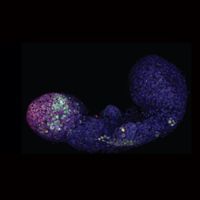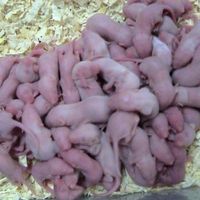Login
Subscribeembryonic stem cells

One Protein to Rule Them All
Shelby Bradford, PhD | Feb 28, 2024 | 10+ min read
p53 is possibly the most important protein for maintaining cellular function. Losing it is synonymous with cancer.

Researchers Fuse Mouse Chromosomes in Scientific First
Natalia Mesa, PhD | Aug 25, 2022 | 4 min read
The findings will likely help elucidate the effects of chromosome fusions, which can cause disease but have also contributed to evolution.

Promoting Stem Cell Growth and Self-Renewal In Vitro
The Scientist Creative Services Team in collaboration with MilliporeSigma | 2 min read
An engineered laminin substrate facilitates high-quality human stem cell cultures.

Mouse Embryo: No Sperm, Egg, or Uterus Required
Christie Wilcox, PhD | Aug 2, 2022 | 3 min read
Using stem cells and a bioreactor, researchers generated living embryos that survived for more than a week and began to develop internal organs.

Human Blastocyst-Like Structures Made in the Lab
Abby Olena, PhD | Mar 17, 2021 | 4 min read
Two new papers describe the generation of so-called blastoids, which could avoid the use of embryonic cells and make studying early human development much more accessible.

Most Members of Federal Fetal Tissue Ethics Panel Oppose Abortion
Lisa Winter | Aug 3, 2020 | 3 min read
The members of a new advisory board to the NIH met for the first time and will weigh in on federal funding for grants that rely on donated tissue from abortions.

Scientists Grapple with US Restrictions on Fetal Tissue Research
Diana Kwon | Mar 2, 2020 | 6 min read
The Trump administration’s changes to policy involving material donated from abortions have led scientists to adjust their research projects or seek alternative sources of funding.

NIH Scientists Banned from Studying Human Fetal Tissue
Kerry Grens | Jun 6, 2019 | 2 min read
External researchers funded by US federal grants can continue their experiments under tighter scrutiny.

First Mouse Embryos Made from Two Fathers
Abby Olena, PhD | Oct 11, 2018 | 3 min read
The bipaternal pups died soon after birth, but mice with two mothers grew into fertile adults.

Mouse Stem Cells Made to Form Embryo-Like Structures
Ruth Williams | Oct 3, 2018 | 3 min read
With just a molecular nudge, aggregates of embryonic stem cells take shape as a “gastroloid,” bearing the genetic hallmarks and spatial organization of early development.

Cardiac Cell Transplants Help Monkeys’ Hearts
Ashley Yeager | Jul 2, 2018 | 2 min read
The organ’s blood-pumping capacity improved with the infusion of cells, a study shows.

Studies Show How Cells Differentiate at Life’s Beginning
Shawna Williams | Apr 27, 2018 | 1 min read
A trio of papers provide new insight into embryo development.

Image of the Day: Retinal Cell Implant
The Scientist and The Scientist Staff | Apr 17, 2018 | 1 min read
For the first time, a transplant of replacement tissue grown from stem cells has been shown to be feasible for patients with macular degeneration.

Researchers Argue for “Embryoid” Ethics Revamp
Bob Grant | Mar 22, 2017 | 2 min read
Scientists issue a call to reconsider the rules governing the creation of tissues, organs, and other structures made possible by recent advances in synthetic biology.

Meet the First Artificial Embryo Made From Stem Cells
Bob Grant | Mar 2, 2017 | 2 min read
Researchers report growing a mouse embryo using two types of early stem cells.

Week in Review: October 17–21
Jef Akst | Oct 20, 2016 | 2 min read
Report finds that pathologist involved in anonymous defamation case committed multiple acts of misconduct; growing eggs from stem cells; neutrophils’ role in metastasis; convergent evolution in birds

Toward Making Sperm in the Lab
Rina Shaikh-Lesko | Feb 25, 2016 | 3 min read
Researchers devise a technique for creating gametes from murine embryonic stem cells.

Legacies Left Behind in 2015
Karen Zusi | Dec 30, 2015 | 5 min read
A look at the contributions of some of the prominent researchers who died this year

New Stem Cell Identified
Anna Azvolinsky | May 6, 2015 | 4 min read
Researchers isolate an easy-to-manipulate, stable, and spatially distinct pluripotent cell type.
